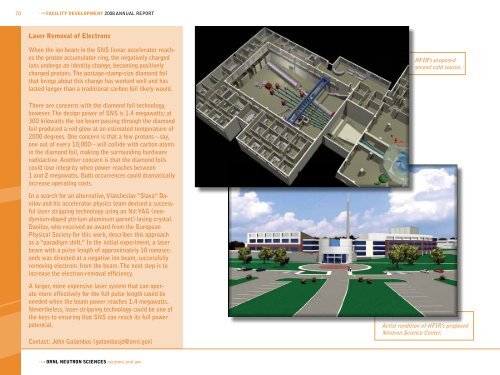Neutron Sciences 2008 Annual Report - 17.79 MB - Spallation ...
Neutron Sciences 2008 Annual Report - 17.79 MB - Spallation ...
Neutron Sciences 2008 Annual Report - 17.79 MB - Spallation ...
You also want an ePaper? Increase the reach of your titles
YUMPU automatically turns print PDFs into web optimized ePapers that Google loves.
70<br />
FACILITY DEVELOPMENT <strong>2008</strong> ANNUAL REPORT<br />
Laser Removal of Electrons<br />
When the ion beam in the SNS linear accelerator reaches<br />
the proton accumulator ring, the negatively charged<br />
ions undergo an identity change, becoming positively<br />
charged protons. The postage-stamp-size diamond foil<br />
that brings about this change has worked well and has<br />
lasted longer than a traditional carbon foil likely would.<br />
There are concerns with the diamond foil technology,<br />
however. The design power of SNS is 1.4 megawatts; at<br />
300 kilowatts the ion beam passing through the diamond<br />
foil produced a red glow at an estimated temperature of<br />
2000 degrees. One concern is that a few protons—say,<br />
one out of every 10,000—will collide with carbon atoms<br />
in the diamond foil, making the surrounding hardware<br />
radioactive. Another concern is that the diamond foils<br />
could lose integrity when power reaches between<br />
1 and 2 megawatts. Both occurrences could dramatically<br />
increase operating costs.<br />
In a search for an alternative, Viatcheslav “Slava” Danilov<br />
and his accelerator physics team devised a successful<br />
laser stripping technology using an Nd:YAG (neodymium-doped<br />
yttrium aluminum garnet) lasing crystal.<br />
Danilov, who received an award from the European<br />
Physical Society for this work, describes this approach<br />
as a “paradigm shift.” In the initial experiment, a laser<br />
beam with a pulse length of approximately 10 nanoseconds<br />
was directed at a negative ion beam, successfully<br />
removing electrons from the beam. The next step is to<br />
increase the electron-removal efficiency.<br />
A larger, more expensive laser system that can operate<br />
more effectively for the full pulse length could be<br />
needed when the beam power reaches 1.4 megawatts.<br />
Nevertheless, laser-stripping technology could be one of<br />
the keys to ensuring that SNS can reach its full power<br />
potential.<br />
Contact: John Galambos (galambosjd@ornl.gov)<br />
ORNL NEUTRON SCIENCES neutrons.ornl.gov<br />
HFIR’s proposed<br />
second cold source.<br />
Artist rendition of HFIR’s proposed<br />
<strong>Neutron</strong> Science Center.
















